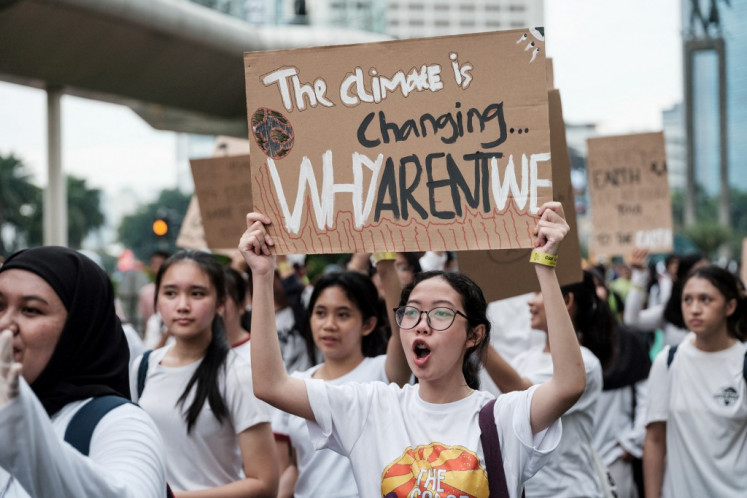Oil claws back up supported on declining supply
After a tumultuous year- end, oil prices have been clawing their way up since the start of 2019 and the trend is expected to continue, supported by declining supply and a modest rebound in market sentiment
Change Size

A
fter a tumultuous year- end, oil prices have been clawing their way up since the start of 2019 and the trend is expected to continue, supported by declining supply and a modest rebound in market sentiment.
Front-month ICE Brent crude futures hit both the highest and lowest levels for 2018 during the fourth quarter last year. The European crude benchmark had surged to a near 4-year high of US$86.74 per barrel on Oct. 3, before crashing more than 40 percent to briefly trade below the $50 mark on Dec. 26.
The Middle Eastern crude benchmark Dubai, a key price tracked by Asian importers, also posted a sharp decline during Q4 last year. The S&P Global Platts second-month Dubai swap tumbled 41 percent from the 2018 peak of $82.85 per barrel assessed on Oct. 4 to $49.04 on Dec. 26.
But prices have since rebounded, largely driven by production cuts by the world’s largest oil exporter Saudi Arabia. Platts’ latest survey showed the Organization of the Petroleum Exporting Countries (OPEC) crude production in December at 32.43 million barrels of oil per day (bopd), a six-month low and down 630,000 bopd from November.
According to Platts Analytics, fundamentals are supportive of higher prices in 2019.
Saudi Arabia, whose energy minister, Khalid al-Falih, was a driving force behind the forging of the latest 1.2 million bopd output cut agreement aimed at shoring up slumping oil prices, lowered its output by 401,000 bopd in December to 10.60 million bopd, the Platts survey showed.
And the Saudis are not expected to stop there. Committed to putting a floor under oil prices, Falih on Jan. 9 said that the kingdom was prepared to lower output further in January to 10.2 million bopd, translating into exports of 7.2 million bopd this month and 7.1 million bopd in February. This would be down 1 million bopd from an all-time high production of 11.02 million bopd in November.
The cuts are aimed at keeping global oil inventories at levels “close to where they need to be”, Falih said. The oil stock levels of the Organization for Economic Cooperation and Development (OECD) rose above the five-year average in October for the first time since March, to 2.872 billion barrels, reflecting recent production surges, and led by an unusually strong build in crude stocks, the International Energy Agency noted in December. The monthly increase in crude stocks, at 46.4 million barrels, was the largest since March 2015.
Supplies are expected to tighten further in the coming months as the OPEC/non-OPEC production cut agreement takes full effect, uncertainty around the restart of Libya’s Sharara field continues, and United States crude production growth slows. According to Platts Analytics, fundamentals are supportive of higher prices in 2019 and ICE Brent prices should be in a $60-$70 per barrel range through 2019.
On US production, Platts Analytics forecasts for it to increase by 9 percent, or 1 million bopd, year on year in 2019 to an average of 11.8 million bopd. That growth rate is down from the 15 percent year-on-year climb predicted for end-2018, with output gaining 1.4 million bopd to average 10.8 million bopd.
Market sentiment, meanwhile, has improved after the US Federal Reserve toned down its hawkish stance earlier this month, and the US and China appear closer to a truce on the trade war, but an overall economic slowdown and its potential impact on oil demand growth is still a key downside risk facing oil prices.
S&P Global ratings, is forecasting that global gross domestic product growth will slow this year, led by the US, where expansion may drop to around 2 percent by the end of 2019.
China — the world’s largest importer of crude — will also see its staggering rates of economic growth moderate further. S&P Global Ratings expects the Chinese economy to grow by 6.3 percent in 2019. This is down from a growth rate of 6.7 percent in the first three quarters of 2018.
This is naturally expected to impact oil demand growth. Platts Analytics expects China’s apparent crude demand growth to slow to 3.4 percent in 2019 from the 4.6 percent seen in 2018.
But as market players focus on supply-demand fundamentals and trade flows this year, it is important not to lose sight of geopolitics, which is increasingly influencing decision making across all parts of the resources industry.
Saudi Arabia — the Middle East’s largest producer of oil and its biggest economy — could, for instance, emerge as a concern if social reforms backfire. The actions of Riyadh’s political elite have come under increasing international scrutiny. How the kingdom reacts to these challenges could be a major factor driving oil prices in 2019 and beyond.
Russia’s evolving relationship with the US could be another major geopolitical narrative in 2019. The world’s largest producer of energy and commodities has increasingly clashed with the biggest consumer of crude in a way not seen since the Cold War.
This bilateral relationship will be a key driver for commodity markets.
_____________________
The writer is head of news, APAC for S&P Global Platts.









